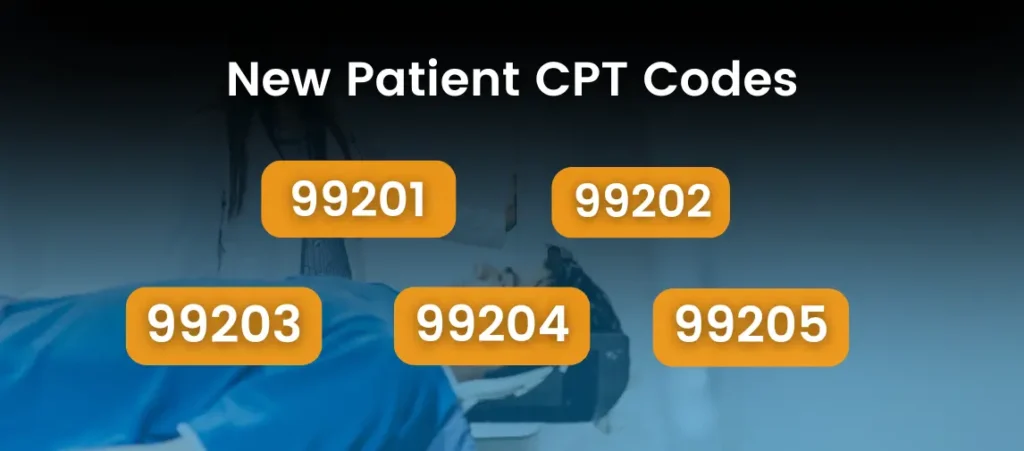Firstly, the new patient CPT code is a cornerstone of medical billing that providers must understand. Accordingly, these codes classify services for patients seeing a healthcare professional for the first time. For example, picking the right code keeps claims accurate and payments on track.
After all, the Current Procedural Terminology (CPT) system, overseen by the American Medical Association, provides codes 99201 to 99205 for new patients. Consequently, each reflects the visit’s scope. To illustrate, a short check-up differs from an in-depth exam. Learn more about updates in Healthcare IT News on 2025 AMA Codes.
“Coding is like trying to herd cats—except the cats are numbers, and they hate you.”
What Defines a New Patient in CPT Coding?
Secondly, a new patient CPT code applies to someone who hasn’t seen the same doctor or group in three years. For instance, a patient switching physicians within a practice remains “established” unless specialties vary widely.
Moreover, this distinction requires extra documentation for new patients. As a result, providers must confirm patient status before coding. In fact, the American Medical Association notes 15% of claim denials tie to status mix-ups. See details in this AAFP coding guide.
Breaking Down the New Patient CPT Code Range
Thirdly, the new patient CPT code range spans 99201–99205. To begin with, these codes differ by time and service level. Meanwhile, this table helps match visits to codes:

| CPT Code | Visit Time | Key Components |
|---|---|---|
| 99201 | 10 minutes | Basic history, simple exam |
| 99202 | 20 minutes | Expanded history, exam |
| 99203 | 30 minutes | Detailed history, exam |
| 99204 | 45 minutes | Comprehensive, moderate |
| 99205 | 60 minutes | Comprehensive, complex |
CPT Code 99201
For instance, CPT 99201 fits a 10-minute visit. Specifically, it includes a basic history and simple exam with easy decisions. In short, it’s ideal for minor issues needing little effort.
CPT Code 99202
Next, CPT 99202 covers 20-minute visits. Accordingly, it involves an expanded history and exam. For example, a patient with a mild condition needing more attention fits here.
CPT Code 99203
Then, CPT 99203 applies to 30-minute visits. To clarify, it requires a detailed history and exam with moderate decisions. As an illustration, a new patient with several small complaints works.
CPT Code 99204
Furthermore, CPT 99204 jumps to 45 minutes. In particular, it demands a comprehensive history and exam with moderate complexity. For one thing, it suits patients with multiple issues to discuss.
CPT Code 99205
Lastly, CPT 99205 handles 60-minute visits. Notably, it covers a comprehensive history, exam, and complex decisions. To demonstrate, a patient with serious, layered conditions fits this code.
Why Accurate Coding Matters for Providers
Fourthly, using the right new patient CPT code avoids claim rejections. Specifically, errors cause delays—industry data shows 20% of 2024 claims were denied due to coding mistakes. Therefore, precision is key.
Furthermore, correct coding speeds up payments. In contrast, errors cost providers $68 per denied claim on average, per a 2023 study. Thus, getting it right matters. Explore tips at Improving Collections with CPT Codes.
“Billing without accuracy is like throwing spaghetti at a wall—some sticks, but most just makes a mess.”
Common Mistakes with New Patient CPT Codes
Next, errors with new patient CPT codes often snag providers. For example, mixing up new and established patients is common. Likewise, using 99203 for a 10-minute visit mismatches service levels.
In addition, skipping time documentation throws off results. As shown above, each code links to specific minutes. Hence, providers should review notes carefully to dodge these traps.
What Happens When Codes Are Misapplied?
Subsequently, misusing a new patient CPT code leads to denials or audits. In particular, insurers reject claims lacking supporting details. To clarify, a 99204 claim needs thorough notes, not a brief jot.
Besides, frequent mistakes may trigger compliance checks. In reality, CMS recovered $3.7 billion from improper payments in 2023. So, staying accurate is critical for providers.
How to Choose the Right New Patient CPT Code
Now that pitfalls are clear, picking the proper new patient CPT code is simple. Initially, verify the patient’s history—new or returning? Then, evaluate the visit: duration and tasks completed.
Afterward, align those details with 99201–99205. By comparison, a 30-minute detailed exam fits 99203. Altogether, this approach keeps coding consistent. See our New Patient CPT Codes Guide.
Time-Based Coding for New Patient Visits
Another key point is time-based coding with new patient CPT codes. Particularly, when counseling takes over, time trumps components. For instance, a 45-minute advice-heavy visit qualifies as 99204.
However, doctors must log “counseling over 50% of time” in notes. Otherwise, the code won’t stand. In short, providers should track this closely. Read more in this Prolonged Service Coding Case Study.
Industry Trends Impacting New Patient CPT Codes
Presently, trends shape how new patient CPT codes are applied. Notably, telehealth surged 154% in 2024, per Health Affairs, changing coding patterns. As an illustration, virtual visits use 99201–99205 with modifiers.
Similarly, value-based care demands detailed records. In effect, providers must adjust to stay current. After all, old habits slow progress. Check updates at CMS Coding Resources.
Best Practices for Managing New Patient CPT Codes
To start, train staff on new patient CPT code rules—ignorance wastes time. Next, use software to verify patient status and visit details. In addition, audit claims monthly to spot errors early.
Overall, proactive habits keep billing smooth. For instance, a 2024 survey found 30% of practices cut denials by 12% with training. Thus, preparation pays off for providers.
Top Questions Answered About New Patient CPT Codes
People often ask, “What’s the difference between 99203 and 99204?” Simply put, it’s 30 versus 45 minutes and detail level. Another query: “Can telehealth use these codes?” Yes, with modifiers like 95.
Additionally, “What if time isn’t logged?” Then, the code relies on components, not duration. In brief, clear answers help providers code confidently. Visit Medical Coding Tips.
Conclusion
To summarize, mastering the new patient CPT code range—99201 to 99205—is vital for healthcare providers. By all means, accuracy reduces errors, speeds payments, and maintains compliance. With this in mind, staying informed and diligent ensures success in medical billing.



